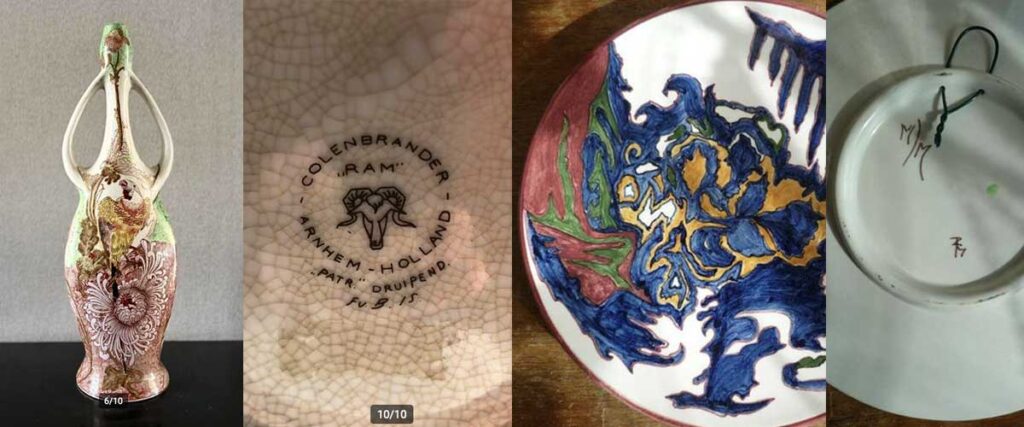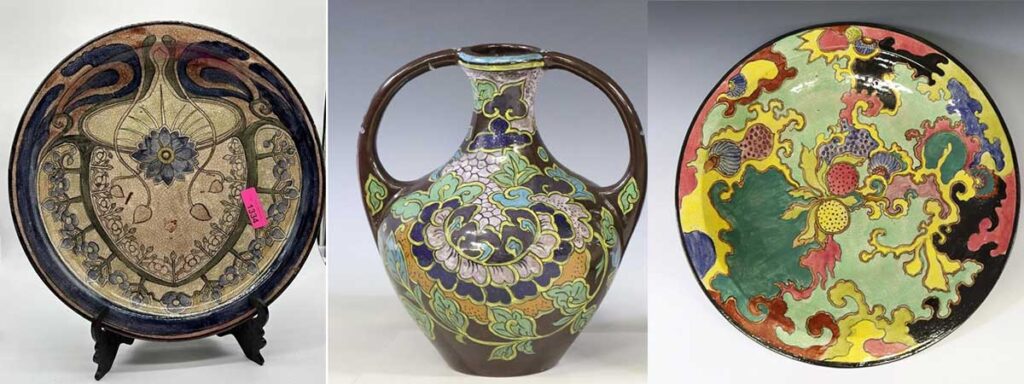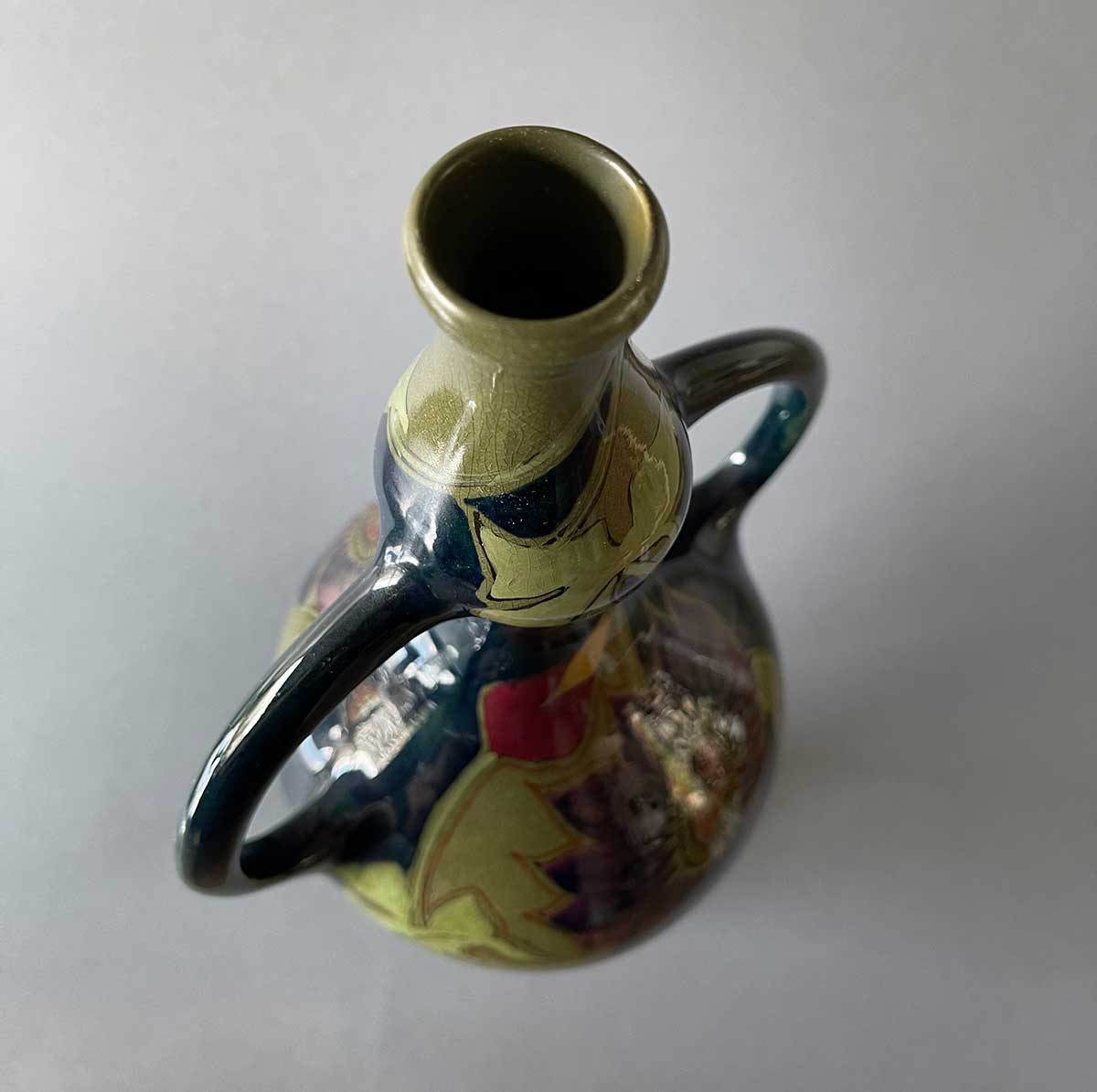Unfortunately, fake antique Dutch Gouda pottery makes its way to auctions, online marketplaces and Catawiki. Because Dutch antique pottery can sometimes be very valuable, it is also counterfeited. Fake Gouda pottery, but also from other companies such as Rozenburg and Ram Arnhem can be recognised by the following characteristics.
Style and Colour
Dutch antique pottery is painted and glazed. Gouda pottery or ‘Gouda Ware’ was made by various factories from the town of Gouda in the period between 1897 and 1965. Antique Dutch pottery, from Gouda and also other town, such as the Hague, Purmerend and Utrecht is older than 100 years and has specific characteristics, such as use of colour and style elements in the design. Especially pottery from the Art Nouveau period (1885-1915) can be recognised by dark colours and the use of elegant shapes (whip motifs) in the decors. Objects are often painted with floral motifs or decorated with birds and butterflies. Or you can recognise Gouda pottery by the pastel shades and the ‘kantjes motifs’, made up of tiny wavy lines and dots on a white background. These are the so-called P- and NP-decors, which are highly sought after by collectors. Antique Gouda or Rozenburg pottery often has a symmetry in its design. This means that patterns repeat themselves on the decorative pottery.
Examples of fake Gouda pottery

Here you see four examples of fake Dutch antique pottery. You can see that the colours, the composition, the refinement of the paintwork and the finesse of the designs are just not right. Experts can spot these fakes immediately.

These are the bottoms of the fake pieces above. Gouda pottery always has black marks and a clear logo (the Lazarus gate). With the Rozenburg from the Hague, the marks and the logo are correct, but they do not correspond to the painted style of the vase.
Always check the model or decor number of Dutch antique pottery
Counterfeit pottery is not only painted, but also signed in an imaginative way. If the signature is vague or raises questions, it’s a good signal to investigate. A good way to check whether Dutch Gouda or Rozenburg pottery is authentic is to look up the model or decor numbers. Most vases have numbers on the bottom in addition to the factory name. This is often the case with Gouda pottery. With the pottery factory Zuid-Holland from Gouda, the numbers on the bottom of the objects often refer to the model or the decor. You can find pictures of model and decor numbers online to see if the design of the vase and the decorations match the right numbers. A good source for this is the webshop of this website, where all model and decor numbers are mentioned. Or look up the excellent site of Ridgetop Collections database. There you can look up the model number or decor number for early Gouda pottery, by checking the bottom of a vase to see if it is the right one.

Above you see three fake vases from Gouda pottery. The numbers on these vases do not correspond to reality. The dots (right) are also incorrect. These were used as a date for very early Rozenburg, but never for Gouda pottery. The photos come from the English site Goudadesign.co.uk. There are many examples of counterfeit pottery. A very good website to visit!
Very common: counterfeit antique pottery, designed by Theodoor Colenbrander
Theodoor Colenbrander was one of the most important pioneers in the field of Dutch decorative pottery. His pottery is in very high demand by collectors worldwide (and rightly so) and therefore has a high market value. Colenbrander mainly worked for the Rozenburg factory in The Hague and later for ‘Ram’ in Arnhem. Fake pottery, signed by Colenbrander, has been put on the market on a large scale. These are modern copies from abroad or well-intentioned ‘homages’.

Here you see on the left a modern copy of Dutch Art Nouveau pottery. At the bottom you see a stamp that resembles the work of the Ram factory, while the design is more like Rozenburg eggshell porcelain. Even the craquelure is fake. On the right you see a painted wall charger in the style of Theodoor Colenbrander. The design lacks the finesse of the real thing and the signature is wrong.
International counterfeits
Fake pottery is not a typical Dutch phenomenon. Recently, at American auctions in particular, you can increasingly see counterfeit antique Dutch pottery. These pieces are almost indistinguishable from the real thing. But you see that they are fake, because the designs and the factories do not belong together. They also have a very consistent and exaggerated pattern of craquelure (intentionally produced that way) to maintain the illusion of antiquety.

Here you see three examples of recently offered (2023) items at an American auction. The pieces look real, but they are not. The wall charger on the right is signed with the lazarus gate of Plateelbakkerij Zuid-Holland from Gouda, but the design is from Holland factory from the city of Utrecht. The counterfeiters thus combined the decor of one factory with the signature of another. In addition, the items contain an exaggerated pattern of craquelure.

Here you can see the marks on the bottom of the fake objects above. The markings are wrong, especially if you check model numbers and decor numbers. These signatures appeared on several objects. The advice is to take a critical look at the markings before purchasing antique Dutch pottery.
Do you have doubts about the authenticity of your Gouda pottery?
It will not surprise you that counterfeit Dutch Art Nouveau pottery represents very little value on the market. Collectors are of course looking for really good antique pieces of Gouda pottery, Rozenburg pottery or Dutch decorative pottery from other factories. Do you have antique Dutch pottery (with the exception of Delft ware) and are you unsure about its authenticity? We provide free evaluations based on photos via email. On this page, you will find more information: appraisal Dutch Pottery.

